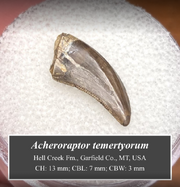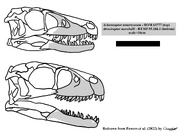Acheroraptor is an extinct genus of dromaeosaurid dinosaur that lived in Late Cretaceous North America.
History[]
David C. Evans, Derek W. Larson and Philip J. Currie (2013) described Acheroraptor, named after the Greek Ἀχέρων (Acheron), "underworld", in referencing the provenance in the Hell Creek Formation and the Latin raptor, "thief". The species epithet refers to James and Louise Temerty, the chairman and ROM Board of Governor and wife, who supported the Royal Ontario Museum for years.
Description[]
ROM 63777, a full right maxilla with several articulated and isolated teeth, is the holotype. A referred specimen is ROM 63778, a mandible. Both, housed in the ROM, are from the upper Hell Creek, Montana, collected ~4 meters apart in the same mixed faunal bonebed. This dates to the Latest Maastrichtian, just before the Chicxulub impactor. The holotype was collected on August 28, 2009 by commercial fossil hunters, one of which collected the dentary some years later. They provided detailed geographic data from GPS and photos of the specimen in situ the day of discovery. Both were purchased by the ROM from a private collector.
Paleoecology[]

A supposed Acheroraptor tooth.

Skull diagrams of Acheroraptor and Atrociraptor skulls, redrawn from Powers et al. (2022).
Acheroraptor is the youngest dromaeosaurid. The Hell Creek Formation has been dated to 66 ± 0.07 million years ago, around the time of te K-PG mass extinction. The flora and fauna reported is rich, with Acheroraptor reported from the Tyrannosaurus-Triceratops fauna. Evans et al. found it was the only Hell Creek dromaeosaur, with teeth once referred to Dromaeosaurus and Saurornitholestes reclassified as Acheroraptor. They also found it was probably the only dromaeosaur. However, in 2015, this was disproven with the discovery of Dakotaraptor, a far larger animal.
Tyrannosaurids, ornithomimids, troodontids, birds and caenagnathids are reported. Tyrannosaurids are Tyrannosaurus, and the likely junior synonym Nanotyrannus. Struthiomimus, Ornithomimus (now thought to be a different, closely-related ornithoimosaur) and "Orcomimus" are ornithomimids. Avisaurus, Brodavis baileyi, two unnamed hesperornithoforms and maybe Potamornis are present birds. Anzu, Leptorhynchos and a possible undescribed form (similar to Gigantoraptor are reported oviraptorosaurs. However, as of 2016, only footprints are known, but were reassigned to tyrannosaurs. Troodontids reported are Troodon (invalid), Pectinodon and Paronychodon (dubious?). Richardoestesia is the only coleurosaur.
Ornithischians are abundant. Ankylosaurus (ankylosaurid) and Denversaurus (nodosaurid) are known, with Edmontonia being a possibility. A leptoceratopsid (Leptoceratops), Nedoceratops and Tatankaceratops (chasmosaurines; dubious?) and Triceratops (chasmosaurine} are ceratopsians. Hadrosaurs include Edmontosaurus and a Parasaurolophus-like taxon. Sphaerotholus and Pachycephalosaurus are reported, with Stygimoloch and Dracorex being proposed (or possibly a new species of Pachycephalosaurus), with another undescribed specimen from North Dakota.
Mammals are plentiful in Hell Creek: Paracimexomys, Paressonodon, Meniscoessus, Essonodon, Cimolemys, Cimolodon, Cimexomys, Mesodma, Neoplagiaulax, Alphadon. Protalphodon, Turgidodon, Pediomys, Protolambda, Leptalestes, Didelphodon, Nancuris, Nortedelphys, Glasbius, Alostera, Protungulatum, Cimolestes, Batodon, Gypsonictops and possibly Paranyctoides are reported.
Classification[]

Credit: Liam Elward, Danielle Dufault and Evans et al. (2013).
Evans et al. (2013) explored the phylogenetic placement of Acheroraptor with several data matrices. Both pecimens were coded as a single taxa in the Turner et al. (2012) data matrix. They recovered Acheroraptor as a member of the clade featuring eudromaeosauria and microraptoria, confirming it was a dromaeosaur, and possibly a eudromaeosaur. However, the taxa were in a large polytomy, because of the limited codings available.
Evans et al. (2013) also coded the specimens, both together and separate, into an updated, smaller dataset of Longrich and Currie (2009). Velociraptor osmolskae and Balaur were added, with Itemirus excluded (due to Miyashita and Currie (2009) finding it was a tyrannosauroid) and the Adasaurus codings were separated into the holotype and IGM 100/23 (following Turner et al. (2012). Additionally, some characters were rescored and modified, with two maxillary characters added into Turner et al. (2012)'s matrix. They found a topology more resolved, placing the taxon as a relatively basal velociraptorine, which was thought to only include Asian taxa. They found the following cladogram:
| Velociraptorinae |
| |||||||||||||||||||||||||||
One unpublished thesis places Acheroraptor in Saurornitholestinae. Records of Sauroritholestes teeth from Hell Creek may be explained by this[citation needed].
